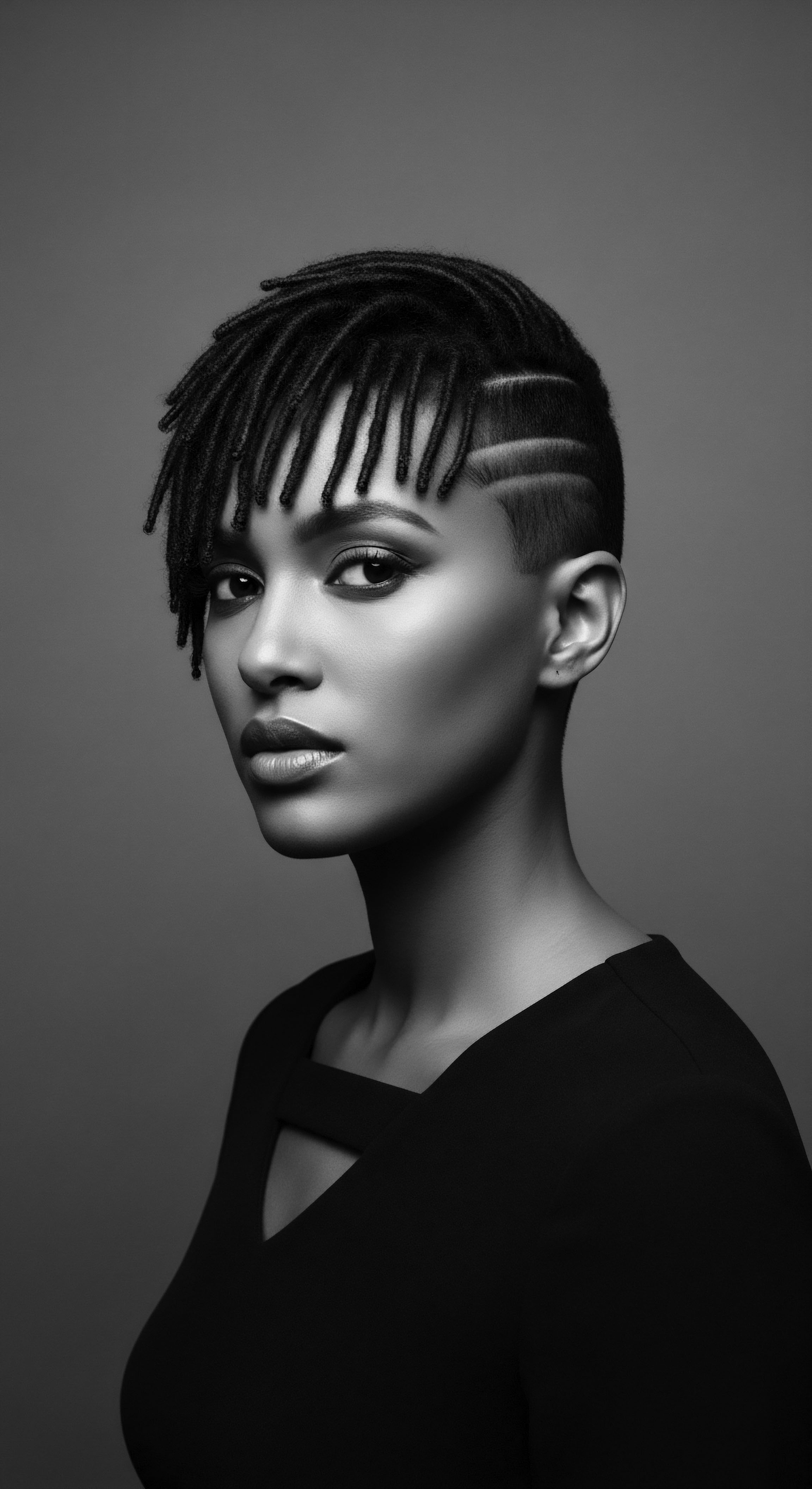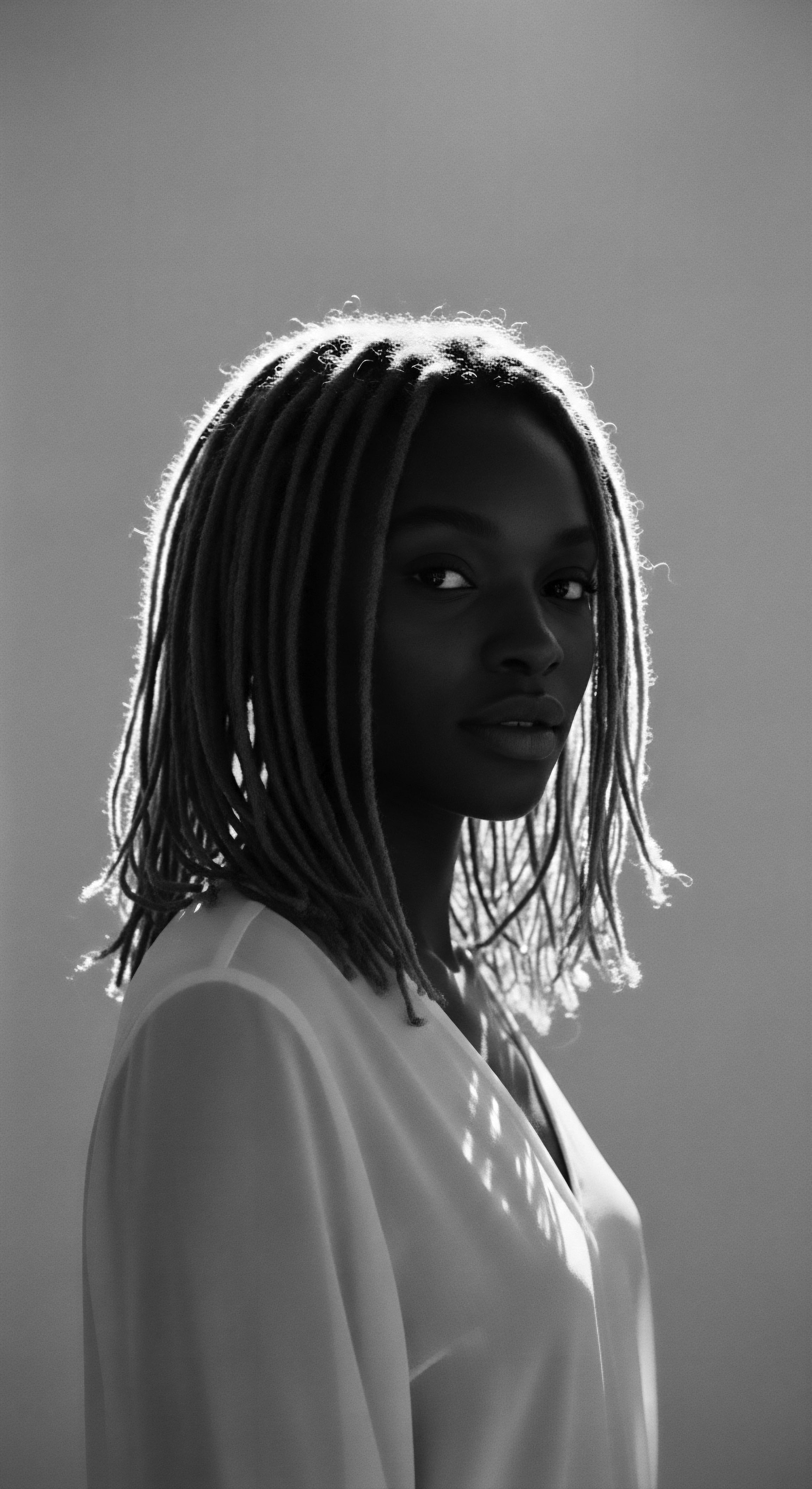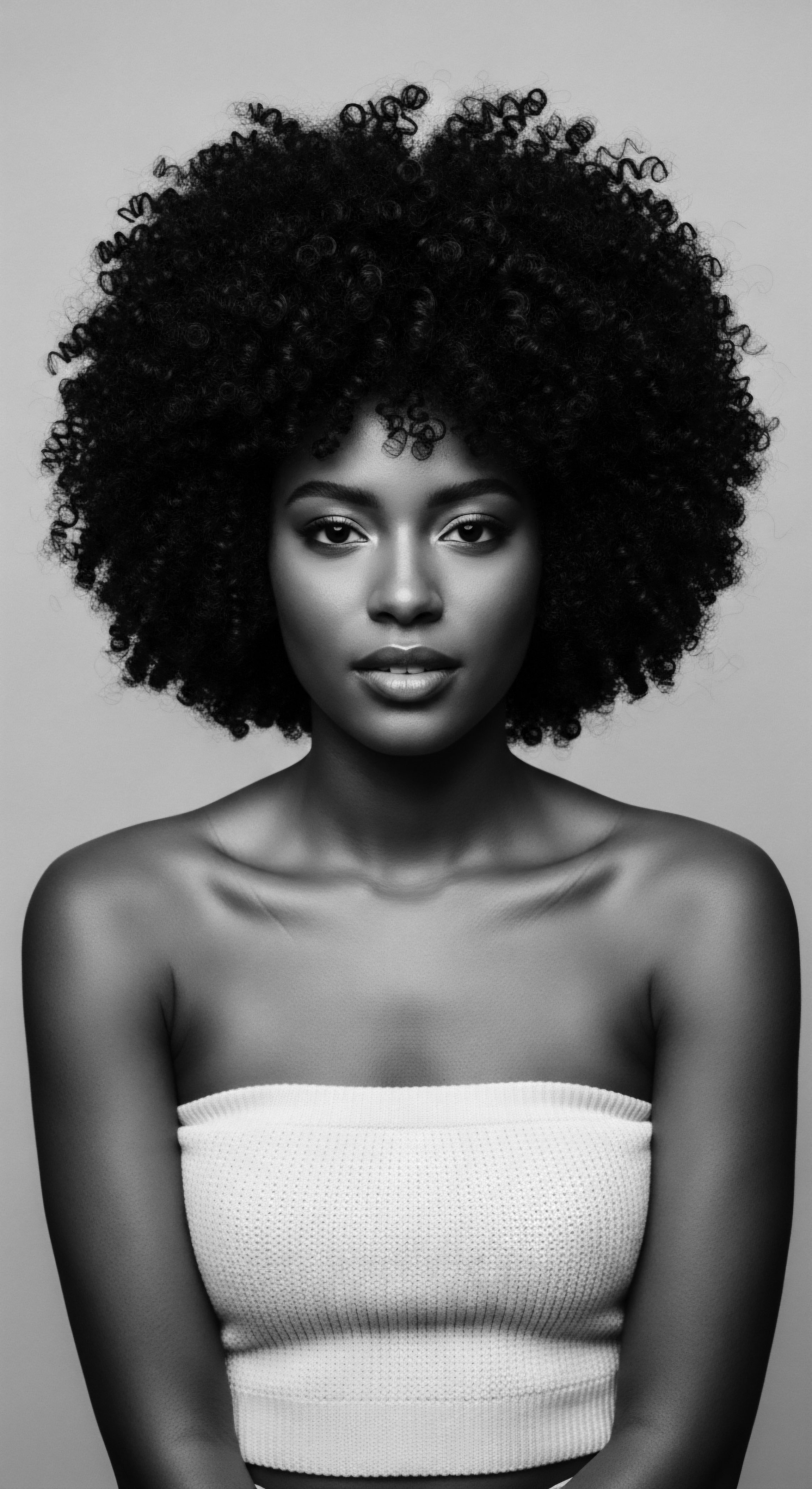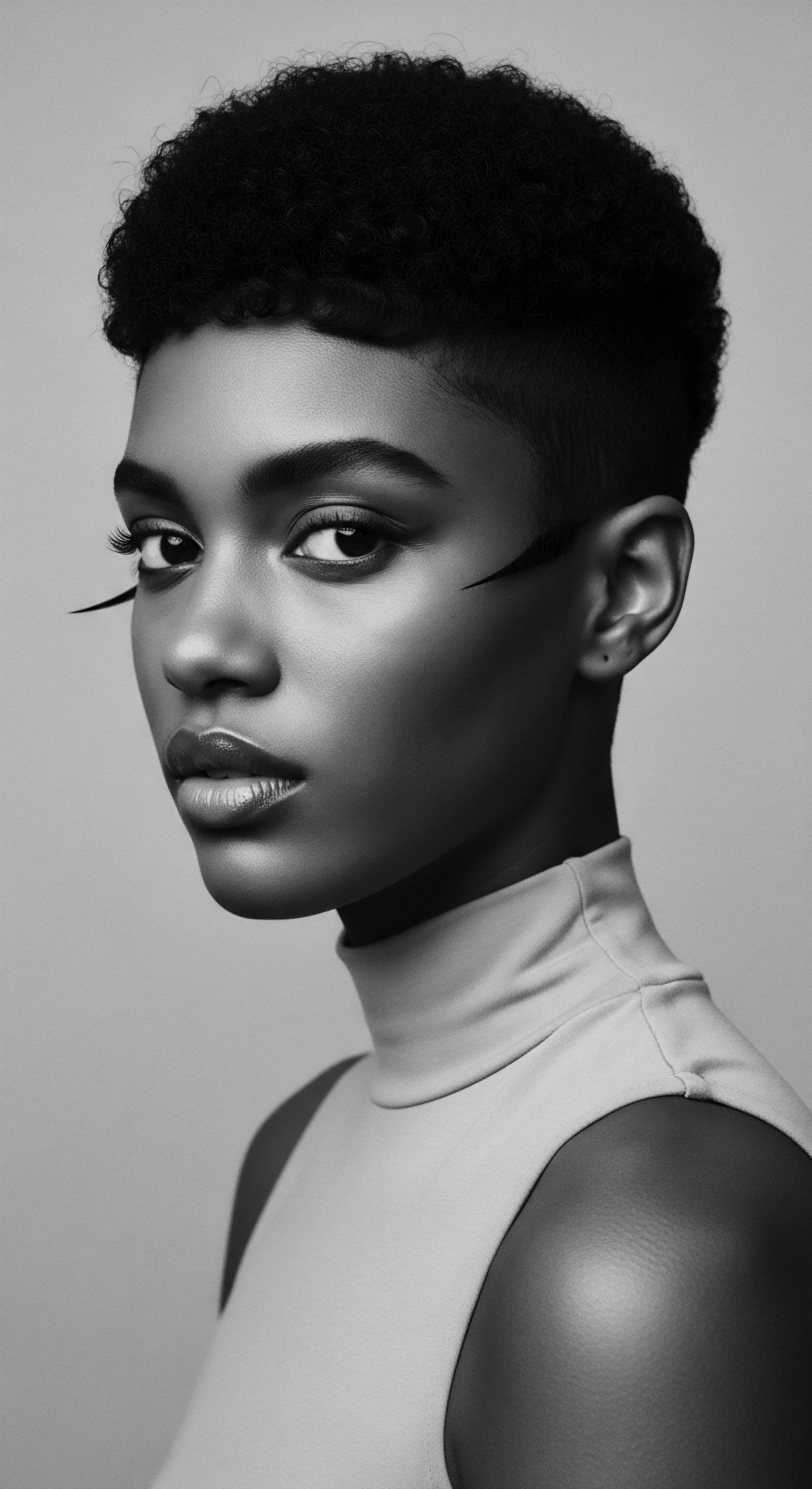
Fundamentals
The concept of Esteban Miró, in its most accessible articulation, refers to the inherent wisdom and ancestral blueprint woven into the very strands of textured hair. It represents a foundational understanding that transcends mere aesthetic considerations, reaching into the biological and cultural origins of hair itself. This interpretation posits that textured hair, particularly that of Black and mixed-race communities, carries within its structure a deep memory—a legacy of adaptation, resilience, and connection to ancient ways of being and knowing.
For those beginning to unravel the profound significance of their hair, perceiving Esteban Miró allows a recognition of hair not as a challenge, but as a living archive, offering clarity regarding its natural tendencies and needs. Its meaning, at this initial juncture, rests upon acknowledging hair as an integral, living part of one’s heritage, a biological continuation of ancestral lineages.
Esteban Miró, fundamentally, is the intrinsic ancestral wisdom and biological blueprint held within every textured hair strand, guiding its nature and calling for a reverence for its heritage.
Consider the elemental biology of textured hair, often characterized by its unique curl patterns, varying porosity, and distinct density. These attributes are not random deviations; they are the result of generations of evolutionary adaptation, a testament to the diverse environments from which Black and mixed-race peoples originated. The hair’s natural inclination to coil or zig-zag, its thirst for moisture, and its collective strength when gathered are all whispers of this ancient design.
Recognizing this inherent nature, as part of Esteban Miró, allows us to approach hair care with a gentle hand, attuned to its intrinsic rhythm rather than imposing foreign ideals upon it. This initial elucidation offers a foundational understanding that positions textured hair as a repository of knowledge, passed down through millennia.

The Hair’s Ancient Whisper
The earliest iterations of human hair care, stretching back through time, were intimately connected to the environment and the resources available. Our ancestors, acutely aware of their surroundings, learned to utilize the botanical gifts of the earth to sustain the vitality of their crowns. These primal practices, though seemingly simple, formed the bedrock of sophisticated care rituals, guided by an intuitive understanding of the hair’s needs. The very biology of textured hair, with its unique follicular structure, speaks to this ancient bond with nature.
It is an adaptation, a shield against intense sun, a regulator of temperature, and a visual marker of community belonging. The interpretation of Esteban Miró begins here, in the recognition of hair as a profound expression of elemental biology and ancestral ingenuity.

Early Kinship with Strands
In ancestral communities across Africa, hair care was not merely a functional task; it was a communal ritual, a moment of profound connection and knowledge transmission. The tending of hair often involved the gathering of natural ingredients from the earth, transformed through skilled hands into nourishing balms and protective washes. The earliest forms of this care were often rooted in the principles of maintaining moisture, protecting the scalp, and ensuring the hair’s strength—principles that modern science now affirms as vital.
This communal activity provided a space for storytelling, for sharing wisdom, and for reinforcing familial and communal bonds. The very meaning of Esteban Miró, in these early contexts, was tied to the hands that cared, the voices that shared, and the collective heritage that was preserved through each strand.
Essential to these early practices were specific elements drawn directly from nature’s generous offering.
- Water ❉ Revered as the primary cleanser and a conduit for spiritual connection, water was essential for purifying and hydrating the strands.
- Plant-Based Cleansers ❉ Often derived from saponin-rich barks or leaves, these gently purified the hair without stripping its vital oils, respecting its natural integrity.
- Emollients ❉ Natural butters and oils, like shea, palm, or baobab, were applied to seal in moisture and provide nourishment, mirroring the hair’s inherent need for lubrication.
- Herbal Infusions ❉ Decoctions of various leaves and roots, prized for their medicinal and fortifying properties, were used as rinses to soothe the scalp and strengthen the hair fiber.
The deep connection between these natural resources and hair health speaks volumes about the early understanding of Esteban Miró, wherein hair was understood as an extension of the earth itself, requiring nurturing from its bounty.

Intermediate
Esteban Miró, at a more intermediate level of apprehension, represents the vibrant, living archive of cultural practices and community knowledge intrinsically linked to textured hair. Its significance transcends the individual, embodying the collective wisdom of generations. This perspective allows one to grasp how hair, within Black and mixed-race experiences, becomes a dynamic canvas for identity, communication, and social expression.
The concept illuminates the way specific styling techniques, rituals, and adornments became profound carriers of cultural meaning, reflecting societal roles, spiritual beliefs, and even historical narratives. The meaning here extends beyond basic biological understanding to the rich tapestry of human interaction with, and symbolic interpretations of, hair throughout history.
Esteban Miró, viewed intermediately, is the living cultural archive of textured hair, where styles and rituals convey identity, social standing, and communal history across generations.
For centuries, throughout diverse African societies, hair acted as a visual language, conveying complex messages without uttering a single word. Hairstyles indicated a person’s family history, social class, spiritual connection, tribal affiliation, and marital status. This intricate communication system meant that a glance at one’s coiffure could reveal a wealth of information about their place in the world.
The practice of hair styling was not merely a chore but a social ritual, a communal gathering where stories were exchanged, bonds were strengthened, and the intergenerational transfer of knowledge solidified. This collective approach to hair, infused with shared meaning and purpose, forms a central pillar of Esteban Miró’s deeper interpretation.

Cultural Cartographies of the Crown
Before the ravages of colonization, African societies held sophisticated understandings of hair, treating it as a sacred and communicative element of identity. The variations in braids, twists, and locs were not arbitrary choices; they were intentional expressions. For example, among the Yoruba people, hair was considered the highest point of the body, a conduit for spiritual energy connecting individuals to their ancestors and deities. Braided hairstyles were sometimes created to send messages to, or communicate with, gods and goddesses.
This profound spiritual link meant hair care was not just for external appearance, but for inner spiritual alignment. The specificity of styles could also indicate marital status, fertility, or rank within a community.
| Hair Aspect or Style Braids and Patterns |
| Cultural Significance Tribe, social status, age, marital status, family background, communication |
| Contributing Regions/Groups Widespread across West, East, and Central Africa (e.g. Yoruba, Igbo, Maasai) |
| Hair Aspect or Style Locs (Dreadlocks) |
| Cultural Significance Spirituality, identity, connection to divine |
| Contributing Regions/Groups Himba people (Namibia), Ethiopian Coptic Orthodox Church |
| Hair Aspect or Style Hair Wraps/Headscarves |
| Cultural Significance Status, modesty, protection, wisdom, strength |
| Contributing Regions/Groups Yoruba and Igbo (gele), Kenya and Tanzania (dhoop/leso) |
| Hair Aspect or Style Hair Length/Condition |
| Cultural Significance Health, wealth, ability to produce bountiful farms/children (for women) |
| Contributing Regions/Groups Nigeria, various West African communities |
| Hair Aspect or Style These examples reflect the profound integration of hair into the social, spiritual, and personal lives of African peoples, a testament to the depth of Esteban Miró's cultural legacy. |

Passing Down the Sacred Touch
The communal practice of hair styling was a significant ritual, especially among women, fostering deep connections and facilitating the transfer of traditional knowledge. Girls and women of varying life stages received hair care from their mothers or elders, often in styles that marked their status within the tribe. Rites of passage, such as marriage or initiation into adulthood, frequently involved specific styles and preparations, creating special bonds among participants. This tradition of shared hair care, as a memorable experience between a mother and daughter, continues even today, reaffirming the enduring nature of these ancestral practices.
One powerful, albeit somber, example illustrating the profound connection between hair, heritage, and survival occurred during the Transatlantic Slave Trade. As millions of Africans were forcibly transported to the Americas, a remarkable act of resistance and cultural preservation transpired:
Enslaved African women ingeniously braided rice seeds into their hair before being forced onto slave ships, ensuring the survival of staple crops and a vital piece of their homeland’s heritage in the Americas.
This poignant historical instance showcases hair not just as a cultural marker but as a literal vessel for sustaining life and heritage. Dutch ethnobotanist Tinde van Andel has extensively researched this phenomenon, corroborating oral traditions passed down through generations in Maroon communities in Suriname and French Guiana. These women, often rice farmers in their homelands, carried the precious Oryza glaberrima, a West African rice variety, concealed within their intricately braided hair. This act of defiance allowed them to carry a vital food source and a piece of their agricultural knowledge and cultural identity across the brutal Middle Passage.
The survival of these rice varieties in the Americas, cultivated by the descendants of these enslaved peoples, speaks to the immense resilience and agency embedded within their hair. It reveals a deep layer of Esteban Miró, where hair literally became a tool for biological and cultural continuity against overwhelming odds. This historical example underscores the concept of hair as a living repository of survival strategies, an embodiment of ancestral wisdom under extreme duress.
The detailed craft of traditional hair styling went beyond aesthetics; it conveyed stories, maps, and even acted as a secret means of communication.
- Cornrows as Maps ❉ During the Transatlantic Slave Trade, enslaved Africans, particularly women, used cornrows to create and transfer maps for escaping plantations. The intricate patterns could subtly depict escape routes, landmarks, and meeting points, hidden in plain sight.
- Identity Markers ❉ Specific braid patterns or styles identified tribal affiliation, social standing, and marital status, providing a non-verbal language within communities. This allowed for rapid identification and cultural cohesion even in foreign lands.
- Rice Seed Concealment ❉ As mentioned, the practice of braiding rice seeds into hair by West African women ensured the propagation of vital crops in new lands, a powerful act of resistance and cultural survival.
- Spiritual Conduits ❉ Many cultures, like the Yoruba, viewed hair as the body’s highest point, a spiritual antenna connecting individuals to the divine and ancestors. Specific styles could be crafted for spiritual ceremonies or communication.
These examples underscore how hair, through Esteban Miró, was not merely an appendage, but a profound cultural artifact, a silent communicator, and a symbol of enduring spirit.

Academic
The academic understanding of Esteban Miró posits it as an interdisciplinary framework, analyzing the profound interplay between the elemental biology, socio-historical forces, and ancestral knowledge that shapes textured hair and its cultural significance. It is a nuanced concept that integrates genetic predispositions, the science of hair morphology, the ethnobotany of traditional care practices, and the complex psychosocial implications of hair identity within Black and mixed-race communities. This advanced interpretation moves beyond descriptive accounts to critically examine how textured hair serves as a living testament to human adaptation, resilience, and the enduring quest for self-determination. The meaning of Esteban Miró, at this level, is a scholarly lens through which to dissect the inherent capabilities of textured hair and the cultural forces that have both celebrated and sought to suppress its natural inclinations, revealing a continuous, dynamic dialogue between heritage and contemporary experience.
Esteban Miró, academically defined, is the complex interplay of genetic inheritance, historical narratives, and ancestral wisdom embodied in textured hair, serving as a profound marker of identity and resilience.
To fully comprehend Esteban Miró from an academic perspective, one must engage with the intricate layers that constitute the lived experience of textured hair. This involves scrutinizing the genetic blueprints that dictate curl patterns and porosity, delving into the ethnobotanical roots of traditional hair care practices, and analyzing the historical currents that have shaped perceptions and policies surrounding Black and mixed-race hair. The concept demands a rigorous, evidence-based approach, demonstrating how ancestral methods often find affirmation in modern scientific discoveries, while also confronting the lingering effects of historical oppression. The analytical depth required to appreciate Esteban Miró at this level allows for a richer, more comprehensive understanding of hair as a site of profound cultural, biological, and psychological significance.

Biogeographical Echoes in the Helix
The biological architecture of textured hair, characterized by its elliptical cross-section and unique follicle curvature, is a remarkable evolutionary adaptation. This distinct morphology, prevalent among peoples of African descent, provided crucial protection against intense solar radiation and regulated scalp temperature in diverse climates. The helical nature of these strands, while sometimes perceived as delicate due to their predisposition to dryness and breakage, possesses an inherent strength and versatility that has allowed for myriad protective styles.
Understanding this biological foundation is central to grasping Esteban Miró, as it anchors the cultural and historical narratives in a tangible, scientific reality. The very shape of the hair strand carries a biogeographical memory, an echo of journeys and adaptations across continents.
Ethnobotanical research increasingly validates the efficacy of traditional plant-based ingredients used in African hair care for centuries. Studies have identified numerous African plant species with properties beneficial for hair and scalp health. For example, a review compiled 68 plant species distributed in Africa traditionally used for hair treatment, targeting issues such as alopecia, dandruff, and lice removal. Of these, 58 species also demonstrated potential as antidiabetic treatments when taken orally, hinting at a holistic ancestral understanding of interconnected wellness.
The Lamiaceae, Fabaceae, and Asteraceae families were particularly well-represented in traditional hair care formulations. This scientific affirmation of ancient practices underscores the wisdom encoded within Esteban Miró, bridging the gap between ancestral knowledge and contemporary understanding.

Colonial Currents and the Crown’s Resilience
The Transatlantic Slave Trade and subsequent colonial regimes instigated a profound and deliberate assault on the cultural significance of Black hair. The act of forcibly shaving heads upon arrival in the Americas was a brutal tool of dehumanization, a systematic attempt to strip enslaved individuals of their identity and connection to their African heritage. This practice aimed to erase the visual language of hair that had communicated tribe, status, and spirituality for millennia. Following emancipation, the pressure to conform to Eurocentric beauty standards led many Black individuals to adopt straightening methods, such as hot combs and chemical relaxers, often internalized as a means of assimilation for economic and social opportunities.
However, the resilience inherent in Esteban Miró ensured that these efforts did not extinguish the cultural fire. Acts of resistance, both overt and subtle, continuously affirmed the profound meaning of textured hair. The example of the Tignon Laws in late 18th-century Louisiana stands as a powerful testament to this enduring spirit. Free Black women were legally mandated to wear headwraps (tignons) to signify their social status, a clear attempt to visually subordinate them.
Yet, these women transformed the tignon into a fashion statement, utilizing luxurious fabrics and elaborate styles to assert their dignity and autonomy, turning a symbol of oppression into an expression of creativity and self-possession. This historical turning point illuminates the deep cultural resistance embedded within the hair journey.
The 20th century witnessed significant shifts, particularly during the Civil Rights Movement, where natural, textured hair emerged as a potent symbol of Black pride, power, and resistance against cultural erasure. The Afro, in particular, became an iconic emblem of liberation and self-acceptance. Today, legislative efforts like the CROWN Act in the United States continue this legacy, prohibiting discrimination based on hair texture and protective styles, acknowledging the historical and ongoing prejudice faced by individuals with textured hair. This ongoing battle for hair freedom underscores the enduring fight for self-determination and the continuous unfolding of Esteban Miró in contemporary society.

Ethnobotanical Wisdom Reclaimed
The renewed interest in ethnobotany offers a scientific lens to validate and reintegrate ancestral hair care practices. Modern research is exploring the bioactive compounds in traditional African plants, confirming their benefits for scalp health, hair growth, and overall hair vitality. For instance, the traditional use of shea butter (from Vitellaria paradoxa) for moisture retention and protection is now understood through its rich composition of fatty acids and vitamins.
Similarly, the efficacy of specific plant extracts for addressing issues like hair loss or dandruff is being investigated, often revealing mechanisms that align with contemporary dermatological understanding. This scientific validation of ancestral wisdom allows for the development of culturally resonant and effective hair care solutions, rooted in the principles of Esteban Miró.
The connection between traditional botanical knowledge and modern hair science is becoming increasingly evident.
- Moringa Oleifera Seed Oil ❉ Historically used for skin and hair care, its high oleic acid content and antioxidant properties are now recognized for nourishing and protecting hair.
- Aloe Vera ❉ A staple in many traditional practices, its moisturizing and soothing properties for scalp health are widely adopted in contemporary shampoos and conditioners.
- Traditional African Clays ❉ Used for centuries to cleanse and detoxify, these clays are now studied for their mineral content and ability to draw out impurities while maintaining hair’s natural balance.
These examples illustrate how the deep, ancestral understanding of botanical properties forms a critical component of Esteban Miró, offering sustainable and effective approaches to textured hair care that resonate with heritage.

Psychosocial Resonance of Identity
The journey of textured hair identity is profoundly psychosocial. The historical marginalization and pathologizing of Black and mixed-race hair have had lasting psychological impacts, contributing to feelings of inferiority and pressures to conform. However, the ongoing movement towards natural hair acceptance and celebration represents a powerful act of reclaiming self-worth and cultural pride. Embracing one’s natural texture, as guided by the principles of Esteban Miró, can be a deeply empowering experience, fostering self-love and a stronger connection to one’s heritage.
This journey often involves navigating complex social landscapes, where hair can still be a site of both discrimination and profound communal affirmation. The ongoing advocacy for hair freedom and the widespread adoption of natural styles signal a collective healing and a renewed appreciation for the inherent beauty and historical significance of textured hair.

Reflection on the Heritage of Esteban Miró
Our contemplation of Esteban Miró reveals a concept far grander than a mere definition; it is a living, breathing testament to the enduring spirit of textured hair and the communities who carry its legacy. From the primal biology that shaped our strands in the crucible of ancient lands, through the intricate social narratives woven into each braid and twist, to the contemporary reclamation of natural beauty, Esteban Miró illuminates an unbroken thread of heritage. It is a concept that urges us to listen to the whispers of our ancestors in the very coils and kinks of our hair, recognizing it as a profound connection to their ingenuity, their resilience, and their unwavering spirit. The journey through Esteban Miró is one of rediscovery, inviting us to see our hair not as a surface adornment, but as a deep root, anchoring us to a rich past and propelling us toward a liberated future.
The “Soul of a Strand” ethos, central to Roothea’s perspective, finds its full expression within Esteban Miró. Each individual strand, whether tightly coiled or gently wavy, carries within it the echoes of survival, the stories of community, and the wisdom of generations who tended their crowns with reverence. It is a reminder that hair care is, at its heart, self-care, a ritual that can bridge the chasm between past and present, connecting us to a collective ancestral memory.
By honoring Esteban Miró, we honor not only our hair but the incredible journey of Black and mixed-race peoples, transforming historical burdens into crowns of unyielding pride. Our textured hair, truly, stands as a vibrant, living archive, a testament to enduring heritage and boundless beauty.

References
- Omotos, Adetutu. “The Symbolism of Hair in Traditional African Culture.” Journal of Pan African Studies, 2018.
- Byrd, Ayana, and Lori Tharps. Hair Story ❉ Untangling the Roots of Black Hair in America. St. Martin’s Griffin, 2014.
- Sherrow, Victoria. Encyclopedia of Hair ❉ A Cultural History. Greenwood Press, 2006.
- Carney, Judith A. “‘With Grains in Her Hair’ ❉ Rice in Colonial Brazil.” UCLA Geography, 2009.
- van Andel, Tinde, et al. “Maroon women still grow rice varieties named after their ancestors who hid seeds in their hair when they escaped slavery in Suriname.” Journal of Ethnopharmacology, 2017.
- Fongnzossie Fedoung, Elvine, et al. “Herbal Cosmetics Knowledge of Arab-Choa and Kotoko Ethnic Groups in the Semi-Arid Areas of Far North Cameroon ❉ Ethnobotanical Assessment and Phytochemical Review.” Diversity, vol. 10, no. 2, 2018.
- Okwu, D. E. “Ethnobotanical Survey of Medicinal Plants Used in Traditional Treatment of Skin Diseases in Nigeria.” Journal of Ethnopharmacology, vol. 116, no. 1, 2008.
- Sultan, Jemal A. et al. “Ethnobotany of traditional cosmetics among the Oromo women in Madda Walabu District, Bale Zone, Southeastern Ethiopia.” Journal of Ethnobiology and Ethnomedicine, vol. 20, no. 1, 2024.
- Fongnzossie Fedoung, Elvine, et al. “Cosmetopoeia of African Plants in Hair Treatment and Care ❉ Topical Nutrition and the Antidiabetic Connection?” Diversity, vol. 16, no. 2, 2024.
